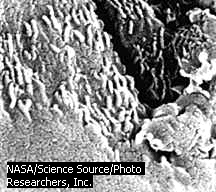








 | |
Panspermia Theory

|

|
Scientists believe this meteorite was probably blasted
off of the surface of the planet Mars about 16 million years ago by an
impact with an asteroid and traveled through space to the earth, where
it landed on Antarctica about 13,000 years ago. Some scientists
believe that the rod-shaped structures across the top and center of
this image may be tiny fossilized bacteria. Many other scientists
believe that the structures were formed by processes other than life.
|
Panspermia
Theory suggests that life seeds came from outer space and planets exchanged life.
Panspermia literally means seeds everywhere.
Panspermia suggests that life could have existed on another planet and moved
to Earth. Statistics have showed 7.5% of rocks from Mars reach Earth. The rocks
would travel between less than 100 years to 16,000 years and more to get to
earth.
Some of the proponents include Sales Gyon de Montlivant, who proposed life
came from moon, H.E. Richter, who suggested life came from meteorites/comets,
and Svante Arrhenius, who came up with Panspermia.
Evidence for Panspermia
1.
Bacteria can survive harsh environment of space
a.
Ultraviolet radiation
b.
Protons bombardments
c.
Cold
2.
Evidence that meteorites contain life
a.
Amino acids (left handed in helicity)
b.
Bacteria
c.
Carbon
d.
Protected inside rocks
3.
Bacteria can live for a long time in sleeping state until awakened
4.
Mars safer than Earth (less bombardments and less gravity)
5.
Mars not as hot as Earth in early development
6.
Mars had have had oxygen back then when earth did not |
Different Scenarios of Panspermia
-
Life
began once, on Mars, and came to Earth in Martian meteorites. May or
may not still exist on Mars (amino acids or bacteria)
-
Life
originated on both Earth and Mars independently. Cross-colonization
(cross-fertilization) may subsequently have occurred (a.a. or
bacteria)
-
Life
began once, on Earth, and was propagated to Mars, where it possibly
established itself (a.a. or bacteria)
-
Life
originated on both Earth and Mars, but in spite of the exchange of
rocks and dust, no transfer of viable organisms has occurred
-
Life
originated on neither Earth nor Mars, but somewhere else entirely,
such as a comet, Jupiterís moon Europa, Venus, or body outside the
Solar System altogether. It came to earth, perhaps Mars too, via some
sort of Panspermia mechanism (a.a. or bacteria)
-
Life
has originated on earth alone and has not (yet) successfully colonized
another planet. Mars is, and always was, lifeless
|
The
theory states that after they arrive safely from space, they became
protein from amino acids and eventually life (if not already). They would then grow
and reproduce, possibly in a warm pond/ocean or underground.
See
Davies' Superbugs for further information on Panspermia |
